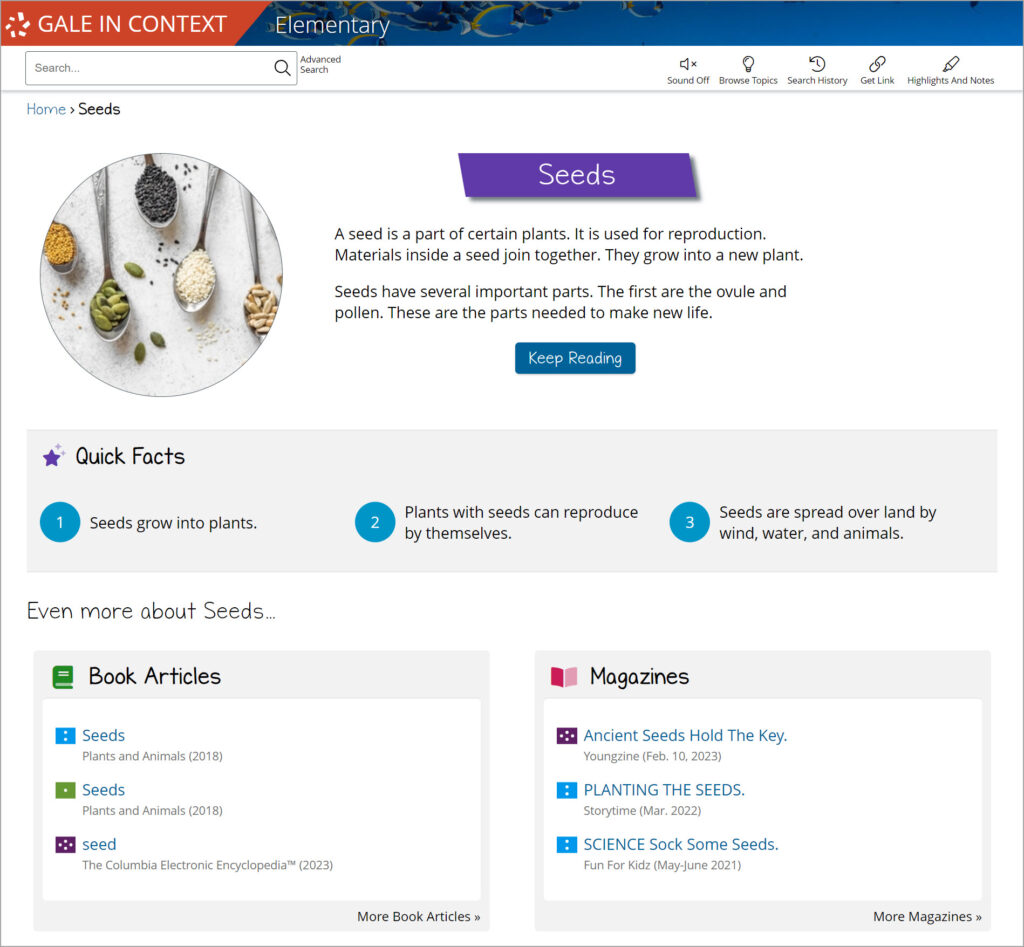| By Gale Staff |
Happy Fall! The first day of the fall season lands on Saturday, September 23. For schools in colder climates, autumn brings colorful leaves, cozy cardigans, and apple cider. The chill of winter feels right around the corner. The community pool is closed, and the school year is underway.
No matter the climate in which you live, elementary teachers can integrate the themes of the changing seasons into their classroom lessons and activities. Using Gale In Context: Elementary, you can find fall-themed inspiration for your subject areas. Gale In Context: Elementary is an age-appropriate, user-friendly database for elementary-level learners. Resources feature colorful graphics and vocabulary assistance for more challenging words, and students can even toggle content between different reading levels to make information more manageable.
Using these customizations, children will grow more confident as they independently develop their beginner research skills. When you embed Gale In Context: Elementary alongside your first day of fall lesson plans, you create a spark for learning and set the stage for a successful school year.
Learn About the Equinox
The first day of fall is called the autumnal equinox. Equinox, which means “equal night” in Latin, describes when light from the sun hits the Earth directly on its Equator. The phenomenon leads to an equal amount of night and day. Introduce this astronomical concept to your elementary science class. Your students have undoubtedly enjoyed the extra daylight hours throughout the summer and subsequent later bedtimes. Encourage them to share their observations about the season’s changing daylight hours.
During summer in the northern hemisphere, the Earth tilts toward the sun. The planet’s position increases sunlight exposure, causing shorter nights and longer days. As the Earth orbits around the sun, its orientation adjusts accordingly. The autumnal equinox defines the period when the northern hemisphere tilts away from the sun, shortening daylight hours and lowering temperatures. As days get darker and chillier, plants and animals adapt accordingly.
Gale In Context: Elementary can help students understand the science behind the changing seasons. Using different resources like the season’s topic page and videos, lessons can meet the needs of diverse learners and help everyone grasp these somewhat abstract astronomical concepts.
Activity Idea: Science is all about observation. Take your scholars outside on a nature walk. What do the plants look like? Are the leaves changing colors? Does the water in the pond feel chilly? Using their different senses, encourage students to share what they experience.
Embrace Change
The changing season marks a necessary time for people to adjust their habits and prepare for winter. While the autumnal equinox signals the ending of the calendar year, it’s truly the beginning of the school year. Embrace the darkening days and crisp weather.
Many cultures worldwide celebrate the start of a new season through different customs and monuments, like Stonehenge. Communities host harvest parties, apple festivals, and hayrides. This time of year offers a chance to create positive changes. Offer students time to organize their desks and lockers, head to the library to check out a new book to read, or introduce some new challenging vocabulary to learn.
Have students discuss how their families adapt to the changing seasons. Do they rake leaves and jump in the piles? Do they eat corn on the cob or other delicious fall crops? Gale In Context: Elementary houses content from different countries and belief systems, helping your students develop new perspectives while also recognizing the values people share.
Activity Idea: Help students create colorful paper leaves using construction paper. Encourage them to write a classroom goal on their autumn leaf. Maybe they could practice their instrument more or commit to spending additional time on their math homework. Students can glue their leaves to a shared poster to create a classroom collage.
Save Seeds for the Spring
Fall brings bountiful harvests like corn, apples, and squash. Ask students to talk about their favorite autumn crops, and you can bring some examples to share. Help young learners identify the seeds. Seeds are often thrown away or composted, but you can also store them for gardening in the spring or roast them as a yummy snack.

Introduce the concept of seed saving for your environmental studies lesson plans. Seeds are essential to protecting the planet’s biodiversity, especially the traditional varieties. With so many crops available, the first day of fall presents a fun opportunity to explore different seeds and discuss a plant’s lifecycle.
Activity Idea: Get hands-on! Bring in a pumpkin, squash, or other familiar autumn crops and show students how to extract the seeds. As a class, wash, dry, and store your seeds in a cool, dry place throughout winter. Come spring, you’ll have your own seeds to plant in the school garden.
Create A+ Lesson Plans
The first day of fall means the school year is fully underway, and teachers are busier than ever. Gale In Context: Elementary is a top-notch tool for young learners, but teachers deserve a dedicated database too. Gale can help educators get a head start on their fall-themed lessons and even plans for the whole academic year. Gale In Context: For Educators is a singular database designed for teachers. Let the changing seasons inspire you to commit to new teaching goals for the school year. Gale In Context: For Educators integrates webinars and tutorials for educators seeking professional development opportunities. As students’ needs evolve, our teaching strategies adapt as well.
Furthermore, educators can use the Support Site to get a head start on lesson planning for the fall semester too. Start with the Fresh Year, Fresh Start collection for back-to-school strategies and new classroom ideas. We’ve compiled a back-to-school portal with how-to guides and tip sheets to share with students and parents, including a specific Gale In Context: Elementary handout. There’s no need to reinvent the wheel each year. Gale’s resources can help you stay organized and ahead of the game.
Discover tips for improving classroom accessibility and new approaches for differentiated learning. By leveraging the Gale Support Site’s lesson plans and support tools, you have more time to create an individualized and engaging environment for your students.
As summer officially ends, rely on Gale’s databases to kick off a successful school year. If your school is not a subscriber, contact your local Gale representative to access a trial.

